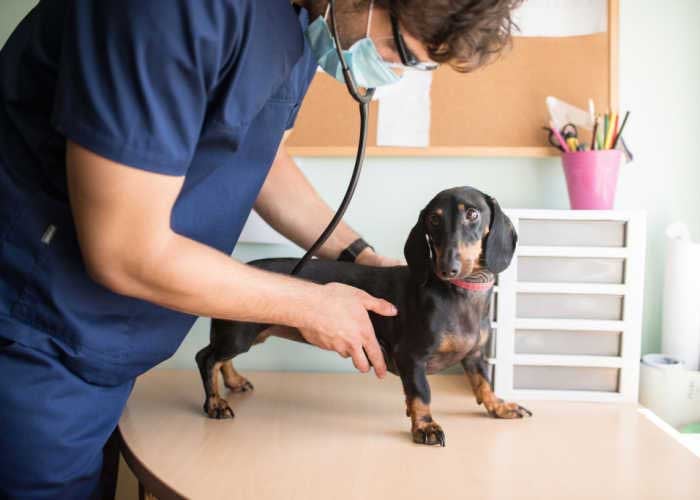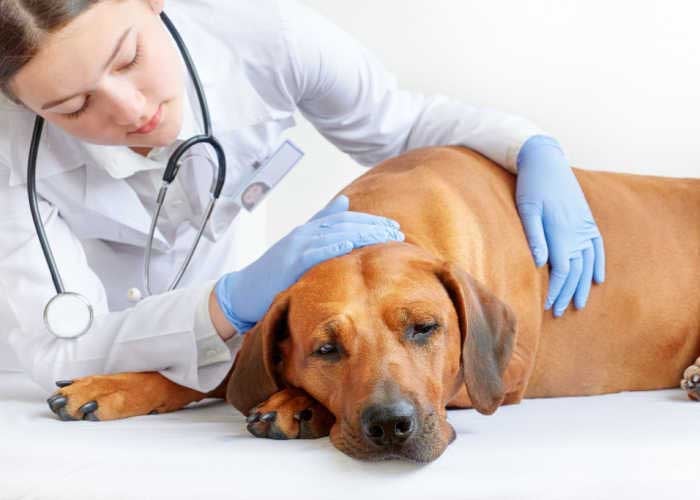Table of Contents
Like all types of cancer, to be diagnosed with the disease can be heartbreaking. But how do you recognize prostate cancer in dogs?
Cancer has been the leading cause of death in dogs. If only there was something we could do to help extend their lives.
Fortunately, there is!
Aside from doing the best ways possible to keep our pets healthy, we can support organizations with their canine cancer research. Through donations, they can make progress in their search for a cure.
Dog charities, such as the National Canine Cancer Foundation, strive to put an end to this major health problem in dogs. They aim to do outreach and help fund universities that study cancer at the cellular level.
Since the mission here is to educate and raise awareness, we will now make an effort to be as detailed as possible on specific dog cancers.
In this article, we will focus on canine prostate cancer.
Prostate Cancer in Dogs
It is a form of cancer that involves tumors originating from the prostate gland.
The prostate gland is located near the urinary bladder of male dogs, with the urethra passing through it to transport urine from the bladder out of the body.
While producing some of the fluids found in semen, it also provides nourishment to the sperm cells and helps in breeding.
When cells within the prostate grow out of control, prostatic tumors develop.
The tumor enlarges the prostate gland so that it presses on the urethra, making it difficult for the dog to urinate. It puts pressure on the rectum, causing problems with defecation as well.
About 1% of male dogs are afflicted with cancer of the prostate, affecting both neutered and non-neutered of any breed. It is more common, though, in older dogs around nine or ten years of age.
According to VCA Animal Hospitals, any breed can be stricken but is more commonly seen in Airedale Terrier, Beagle, Doberman Pinscher, German Shorthaired Pointer, Norwegian Elkhound, Miniature Poodle, Scottish Terrier, and Shetland Sheepdog.
You may wonder what causes prostate cancer in dogs. Well, you should know that the cause of this disease, or any tumor or cancer, is largely unknown.
Although no one exactly knows why prostate cancers develop, it may be linked to a few risk factors such as the environment, neutering too early in life, hormonal imbalance, or simply inherited from those developing the disease.
RELATED: Dog Neutering or Spaying A Dog
Are Prostatic Tumors Benign or Malignant?
Cancer can originate in the prostate gland itself or from another organ that spreads to the prostate.
Although relatively rare, prostate cancer in dogs is fatal and malignant. This disease is typically aggressive that animals with it have a guarded condition to poor prognosis.
It may be hard to determine which type of cancer a dog is suffering from, but the most commonly diagnosed tumor is prostatic adenocarcinoma.
It arises from the glandular tissue in the prostate and is the most malignant type of prostate cancer.
Highly metastatic, it spreads easily in the body and affects organs such as the lungs, lymph nodes, liver, spleen, and other parts of the urinary tract.
The brain and spinal cord may be uncommon sites of spread, but when reached, prostatic adenocarcinoma may result in neurological dysfunction, such as the inability to walk and odd behavior.
The other type of cancer that can affect the prostrate is traditional cell carcinoma which occurs in the urinary system. It grows slowly and is less malignant than adenocarcinoma.
Benign prostatic hypertrophy or noncancerous tumors can also develop in dogs that have not been neutered, though unusual to happen.
Adenocarcinoma, TCC, and BHP are the most common types of prostate diseases in older dogs.
While treatment depends on the progression of the disease, surgery, chemotherapy, and radiation are strongly suggested to improve the chance of survival.
Prostate Cancer Signs and Symptoms
The most notable symptom of dogs with prostate cancer is the presence of blood in their urine.
Other signs associated with the disease include:
- Difficulty in urinating
- Incontinence
- Lethargy
- Weight Loss
- Hind leg lameness
The enlarged prostate in dogs could be pressing on the colon, making it difficult for them to poop and a change in their stool’s shape. But in the early stages of cancer, they may not show any symptoms at all.
See a vet for a proper diagnosis and course of treatment once you see signs that your dog might be suffering from prostate cancer.
You may discuss additional testing to determine and plan the treatments that fit your pup’s needs. Talk about how large the cancer is and whether it has spread to other organs.
Regarding the treatment details, you may raise your concern about which options are recommended. You can also ask how soon you can start the treatment and the potential side effects.
Diagnosis of Prostate Cancer in Dogs
Even if your pet is showing the signs mentioned above, don’t automatically presume he has cancer.
Diagnosis of prostate cancer in dogs may not be easy since its symptoms share much in common with kidney and urinary tract infections.
This condition can go undiagnosed until it reaches an advanced stage and starts to metastasize.
Canine prostate cancer is diagnosed through a combination of clinical signs, advanced diagnostic imaging, and obtaining cells from the prostate for cytology.
Especially in older males, the veterinarian will start performing a thorough physical examination of your pet to check prostate health.
Abdominal and rectal palpation may follow to detect irregularities in the prostate gland or masses in the abdomen.
An enlarged prostate in dogs can be detected through further tests, including urinalysis, contrast X-rays, ultrasound scans, and biopsy of the rectal wall.
X-rays help identify metastasis, while ultrasound determines if the prostate is swollen or has polyps, cysts, or tumors.
The doctor may obtain a sample of cells either by catheterization (insertion of a catheter into the urethra to the prostate) or by performing a fine needle aspiration of the prostate gland.
When a diagnosis cannot be made with either of the procedures, a biopsy may need to be considered.
Removal of a tissue sample confirms whether the tumor is cancerous, as not all enlarged prostates are cancer.
If found to be a case of malignancy, the examination will tell the vet to diagnose cancer.
Additional lab work may also be done to ensure that the internal organs are working properly and that no changes have occurred.
Treatments of Prostate Cancer in Dogs
Surgery to remove the diseased portion of the prostate may be an effective method of treatment for dogs with prostate cancer, followed by radiation therapy or chemotherapy.
However, prostate cancers are non-amenable to surgery due to their location. It is risky and only possible if the disease has not spread to other areas of the body.
So, surgery is not always helpful because cancer has often spread by the time it is discovered.
The other options available are chemotherapy and radiation therapy.
Doctors often use non-steroidal anti-inflammatory drugs to relieve pain. These medicines are supporting tools to keep your dog comfortable and improve its quality of life for as long as possible.
A combination of chemotherapy, NSAIDs, and radiation therapy may increase survival time by an average of 20 months, but still not a guarantee.
Radiation tends to harm the surrounding tissues, and most chemotherapy drugs and protocols have no long-term efficacy established.
Prostrate cancer in dogs is difficult to treat, as the methods mentioned are only palliative measures rather than curative.
Luckily, prostate cancer is rare. Veterinary check-ups may lead to finding prostate cancer early.
If your pet is showing any unusual signs or symptoms, always call your vet’s office for their advice and best recommendations.
As with most cancers, there is no known approach to preventing canine prostate cancer. Treatments focus on both controlling the tumor, as well as addressing the concern for metastasis.
Prognosis and Survival Rate
Even with early detection, the prognosis of dogs with prostate cancer remains poor due to the rate of metastasis. Survival time is short whether or not a definitive treatment is performed.
The disease advances too far to control, with an average survival rate of 6 weeks to 1 year.
Doctors usually do euthanasia once the quality of life starts to deteriorate or when they can no longer manage the clinical signs.
FAQs about Canine Prostate Cancer
How long do dogs live with prostate cancer?
The average survival time is up to a year, with most dogs euthanized due to tumor progression.
Even with successful surgery, postoperative complications can happen to cause urinary incontinence and narrowing of the urethra to the point of being unable to urinate.
How long can a dog live without treatment?
Canine prostate cancer has a poor prognosis due to the aggressive nature of this kind of tumor. If no treatment was pursued, the dog usually lives for around one month.
Is my dog in pain with prostate cancer?
Yes, especially along the back or abdomen. If it is experiencing pain, seek veterinary attention immediately so that your pet’s pain management plan can be modified.
Prostate Cancer in Dogs: Final Thoughts
Cancer should not necessarily mean a death sentence to our canine companions.
Know that research is ongoing for new protocols to develop in treating prostate cancer in dogs.
As a matter of fact, there have been a lot of advancements going on with newer treatments to improve the survival rate.
At PetCure Oncology, they provide pet families with clinical expertise and progressive treatment options.
As the national leader in the veterinary oncology field, it manages a network of cancer care centers committed to delivering industry-leading cancer care for pets.
We understand your pooch is a big part of your family, and you want to give it the best care possible. So, in matters of health, always consult with a veterinarian.
If diagnosed with canine prostate cancer, discuss treatment options and determine the best course of action to give your dog the fighting chance at life.

















